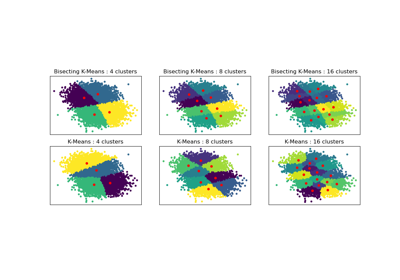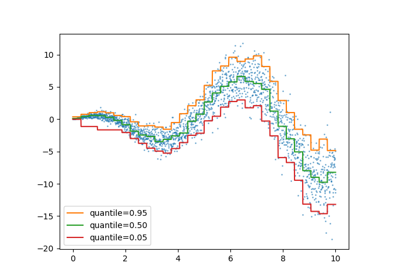sklearn.cluster.BisectingKMeans¶
- class sklearn.cluster.BisectingKMeans(n_clusters=8, *, init='random', n_init=1, random_state=None, max_iter=300, verbose=0, tol=0.0001, copy_x=True, algorithm='lloyd', bisecting_strategy='biggest_inertia')[source]¶
Bisecting K-Means clustering.
Read more in the User Guide.
New in version 1.1.
- Parameters:
- n_clustersint, default=8
The number of clusters to form as well as the number of centroids to generate.
- init{‘k-means++’, ‘random’} or callable, default=’random’
Method for initialization:
‘k-means++’ : selects initial cluster centers for k-mean clustering in a smart way to speed up convergence. See section Notes in k_init for more details.
‘random’: choose
n_clustersobservations (rows) at random from data for the initial centroids.If a callable is passed, it should take arguments X, n_clusters and a random state and return an initialization.
- n_initint, default=1
Number of time the inner k-means algorithm will be run with different centroid seeds in each bisection. That will result producing for each bisection best output of n_init consecutive runs in terms of inertia.
- random_stateint, RandomState instance or None, default=None
Determines random number generation for centroid initialization in inner K-Means. Use an int to make the randomness deterministic. See Glossary.
- max_iterint, default=300
Maximum number of iterations of the inner k-means algorithm at each bisection.
- verboseint, default=0
Verbosity mode.
- tolfloat, default=1e-4
Relative tolerance with regards to Frobenius norm of the difference in the cluster centers of two consecutive iterations to declare convergence. Used in inner k-means algorithm at each bisection to pick best possible clusters.
- copy_xbool, default=True
When pre-computing distances it is more numerically accurate to center the data first. If copy_x is True (default), then the original data is not modified. If False, the original data is modified, and put back before the function returns, but small numerical differences may be introduced by subtracting and then adding the data mean. Note that if the original data is not C-contiguous, a copy will be made even if copy_x is False. If the original data is sparse, but not in CSR format, a copy will be made even if copy_x is False.
- algorithm{“lloyd”, “elkan”}, default=”lloyd”
Inner K-means algorithm used in bisection. The classical EM-style algorithm is
"lloyd". The"elkan"variation can be more efficient on some datasets with well-defined clusters, by using the triangle inequality. However it’s more memory intensive due to the allocation of an extra array of shape(n_samples, n_clusters).- bisecting_strategy{“biggest_inertia”, “largest_cluster”}, default=”biggest_inertia”
Defines how bisection should be performed:
- “biggest_inertia” means that BisectingKMeans will always check
all calculated cluster for cluster with biggest SSE (Sum of squared errors) and bisect it. This approach concentrates on precision, but may be costly in terms of execution time (especially for larger amount of data points).
- “largest_cluster” - BisectingKMeans will always split cluster with
largest amount of points assigned to it from all clusters previously calculated. That should work faster than picking by SSE (‘biggest_inertia’) and may produce similar results in most cases.
- Attributes:
- cluster_centers_ndarray of shape (n_clusters, n_features)
Coordinates of cluster centers. If the algorithm stops before fully converging (see
tolandmax_iter), these will not be consistent withlabels_.- labels_ndarray of shape (n_samples,)
Labels of each point.
- inertia_float
Sum of squared distances of samples to their closest cluster center, weighted by the sample weights if provided.
- n_features_in_int
Number of features seen during fit.
- feature_names_in_ndarray of shape (
n_features_in_,) Names of features seen during fit. Defined only when
Xhas feature names that are all strings.
See also
KMeansOriginal implementation of K-Means algorithm.
Notes
It might be inefficient when n_cluster is less than 3, due to unnecessary calculations for that case.
Examples
>>> from sklearn.cluster import BisectingKMeans >>> import numpy as np >>> X = np.array([[1, 2], [1, 4], [1, 0], ... [10, 2], [10, 4], [10, 0], ... [10, 6], [10, 8], [10, 10]]) >>> bisect_means = BisectingKMeans(n_clusters=3, random_state=0).fit(X) >>> bisect_means.labels_ array([2, 2, 2, 0, 0, 0, 1, 1, 1], dtype=int32) >>> bisect_means.predict([[0, 0], [12, 3]]) array([2, 0], dtype=int32) >>> bisect_means.cluster_centers_ array([[10., 2.], [10., 8.], [ 1., 2.]])
Methods
fit(X[, y, sample_weight])Compute bisecting k-means clustering.
fit_predict(X[, y, sample_weight])Compute cluster centers and predict cluster index for each sample.
fit_transform(X[, y, sample_weight])Compute clustering and transform X to cluster-distance space.
get_feature_names_out([input_features])Get output feature names for transformation.
get_params([deep])Get parameters for this estimator.
predict(X)Predict which cluster each sample in X belongs to.
score(X[, y, sample_weight])Opposite of the value of X on the K-means objective.
set_output(*[, transform])Set output container.
set_params(**params)Set the parameters of this estimator.
transform(X)Transform X to a cluster-distance space.
- fit(X, y=None, sample_weight=None)[source]¶
Compute bisecting k-means clustering.
- Parameters:
- X{array-like, sparse matrix} of shape (n_samples, n_features)
Training instances to cluster.
Note
The data will be converted to C ordering, which will cause a memory copy if the given data is not C-contiguous.
- yIgnored
Not used, present here for API consistency by convention.
- sample_weightarray-like of shape (n_samples,), default=None
The weights for each observation in X. If None, all observations are assigned equal weight.
- Returns:
- self
Fitted estimator.
- fit_predict(X, y=None, sample_weight=None)[source]¶
Compute cluster centers and predict cluster index for each sample.
Convenience method; equivalent to calling fit(X) followed by predict(X).
- Parameters:
- X{array-like, sparse matrix} of shape (n_samples, n_features)
New data to transform.
- yIgnored
Not used, present here for API consistency by convention.
- sample_weightarray-like of shape (n_samples,), default=None
The weights for each observation in X. If None, all observations are assigned equal weight.
- Returns:
- labelsndarray of shape (n_samples,)
Index of the cluster each sample belongs to.
- fit_transform(X, y=None, sample_weight=None)[source]¶
Compute clustering and transform X to cluster-distance space.
Equivalent to fit(X).transform(X), but more efficiently implemented.
- Parameters:
- X{array-like, sparse matrix} of shape (n_samples, n_features)
New data to transform.
- yIgnored
Not used, present here for API consistency by convention.
- sample_weightarray-like of shape (n_samples,), default=None
The weights for each observation in X. If None, all observations are assigned equal weight.
- Returns:
- X_newndarray of shape (n_samples, n_clusters)
X transformed in the new space.
- get_feature_names_out(input_features=None)[source]¶
Get output feature names for transformation.
The feature names out will prefixed by the lowercased class name. For example, if the transformer outputs 3 features, then the feature names out are:
["class_name0", "class_name1", "class_name2"].- Parameters:
- input_featuresarray-like of str or None, default=None
Only used to validate feature names with the names seen in
fit.
- Returns:
- feature_names_outndarray of str objects
Transformed feature names.
- get_params(deep=True)[source]¶
Get parameters for this estimator.
- Parameters:
- deepbool, default=True
If True, will return the parameters for this estimator and contained subobjects that are estimators.
- Returns:
- paramsdict
Parameter names mapped to their values.
- predict(X)[source]¶
Predict which cluster each sample in X belongs to.
Prediction is made by going down the hierarchical tree in searching of closest leaf cluster.
In the vector quantization literature,
cluster_centers_is called the code book and each value returned bypredictis the index of the closest code in the code book.- Parameters:
- X{array-like, sparse matrix} of shape (n_samples, n_features)
New data to predict.
- Returns:
- labelsndarray of shape (n_samples,)
Index of the cluster each sample belongs to.
- score(X, y=None, sample_weight=None)[source]¶
Opposite of the value of X on the K-means objective.
- Parameters:
- X{array-like, sparse matrix} of shape (n_samples, n_features)
New data.
- yIgnored
Not used, present here for API consistency by convention.
- sample_weightarray-like of shape (n_samples,), default=None
The weights for each observation in X. If None, all observations are assigned equal weight.
- Returns:
- scorefloat
Opposite of the value of X on the K-means objective.
- set_output(*, transform=None)[source]¶
Set output container.
See Introducing the set_output API for an example on how to use the API.
- Parameters:
- transform{“default”, “pandas”}, default=None
Configure output of
transformandfit_transform."default": Default output format of a transformer"pandas": DataFrame outputNone: Transform configuration is unchanged
- Returns:
- selfestimator instance
Estimator instance.
- set_params(**params)[source]¶
Set the parameters of this estimator.
The method works on simple estimators as well as on nested objects (such as
Pipeline). The latter have parameters of the form<component>__<parameter>so that it’s possible to update each component of a nested object.- Parameters:
- **paramsdict
Estimator parameters.
- Returns:
- selfestimator instance
Estimator instance.
- transform(X)[source]¶
Transform X to a cluster-distance space.
In the new space, each dimension is the distance to the cluster centers. Note that even if X is sparse, the array returned by
transformwill typically be dense.- Parameters:
- X{array-like, sparse matrix} of shape (n_samples, n_features)
New data to transform.
- Returns:
- X_newndarray of shape (n_samples, n_clusters)
X transformed in the new space.
Examples using sklearn.cluster.BisectingKMeans¶

Bisecting K-Means and Regular K-Means Performance Comparison
